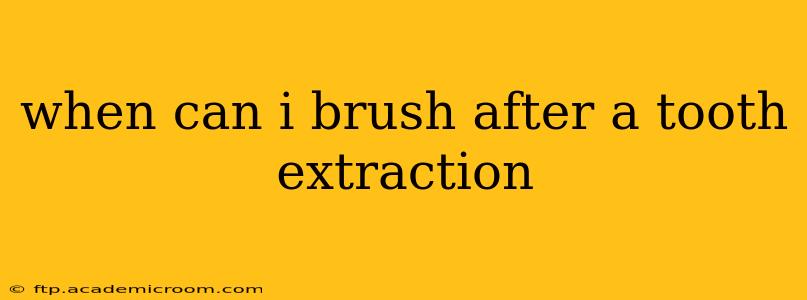When Can I Brush After a Tooth Extraction?
The burning question after a tooth extraction is always: when can I brush my teeth again? The answer isn't a simple one-size-fits-all, as it depends on several factors, including the complexity of the extraction and your individual healing process. However, understanding the proper post-extraction care is crucial for a smooth recovery and preventing complications. This guide will outline the general timeline and considerations.
What Happens Immediately After Extraction?
Immediately following your extraction, your dentist or oral surgeon will place a gauze pad over the extraction site to control bleeding. This typically needs to remain in place for about 30-45 minutes, biting gently to apply pressure. You'll likely experience some swelling and discomfort. During this initial period, brushing is strictly avoided. The wound is extremely vulnerable and brushing could dislodge the blood clot, leading to a painful and potentially serious complication called dry socket.
The First 24 Hours: Gentle Care
For the first 24 hours, focus on gentle rinsing with saltwater. Mix a half-teaspoon of salt into 8 ounces of warm water and gently swish this around your mouth, avoiding the extraction site directly. This helps cleanse the area and prevent infection. Avoid vigorous rinsing, spitting forcefully, or touching the extraction site with your tongue or fingers.
When Can I Start Brushing After 24 Hours?
After the first 24 hours, you can very gently resume brushing, but with some important caveats:
- Avoid the Extraction Site Directly: Focus on brushing the teeth away from the extraction site. Use a soft-bristled toothbrush and be extremely gentle. Avoid any pressure on the area.
- Soft Brushing is Key: Opt for a soft-bristled toothbrush and use gentle, circular motions. Avoid scrubbing or harsh movements.
- Observe Your Body's Signals: If any pain or bleeding occurs, immediately stop brushing and consult your dentist.
How Long Should I Avoid Brushing Near the Extraction Site?
Generally, you can gradually resume normal brushing around the extraction site within a week, but always listen to your body. Your dentist may recommend specific guidelines tailored to your situation. Some individuals may experience faster healing and can brush normally sooner, while others might need to wait slightly longer.
What if I Develop Dry Socket?
Dry socket, or alveolar osteitis, is a painful condition that occurs when the blood clot at the extraction site dislodges. Symptoms include intense pain, a bad taste or odor in the mouth, and a visible empty socket. If you suspect dry socket, contact your dentist immediately. They can provide pain relief and treatment to help the site heal.
How Can I Promote Healing After an Extraction?
Besides gentle brushing, proper post-extraction care includes:
- Following Your Dentist's Instructions: Strictly adhere to any specific aftercare instructions provided by your dentist or oral surgeon.
- Eating Soft Foods: Stick to soft, bland foods for the first few days to avoid irritating the extraction site.
- Keeping Hydrated: Drinking plenty of fluids is essential for healing.
- Taking Prescribed Medication: Follow your dentist’s instructions for any prescribed pain medication or antibiotics.
- Avoiding Smoking and Alcohol: These substances can hinder the healing process and increase the risk of complications.
When Should I Contact My Dentist?
Contact your dentist or oral surgeon immediately if you experience:
- Severe or persistent pain
- Excessive bleeding
- Swelling that significantly increases
- Signs of infection (pus, fever, redness)
- Difficulty opening your mouth
Remember, each individual's healing process is unique. Always follow your dentist's specific recommendations and contact them if you have any concerns. A little patience and gentle care will ensure a smooth and successful recovery after your tooth extraction.
